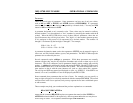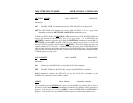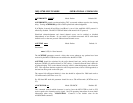
MFJ-1278B MULTI-MODE OPERATIONAL COMMANDS
Parameters
There are several types of parameters. Some parameters can have one of only two values,
such as ON and OFF or EVERY and AFTER, known as KEYWORDS. If a parameter
must be one of two values, the choices are separated by a forward slash, /. You may use YES
instead of ON and NO instead of OFF.
A parameter designated as n is a numeric value. These values may be entered as ordinary
decimal numbers, or as hexadecimal, or "hex", numbers by preceding the number with the $
symbol. When the MFJ-1278B shows some of these numeric parameters, those that set
special characters, they will be given in hex. The "digits" of a hex number represent powers
of 16, analogous to the powers of 10 represented by a decimal number. The numbers 10
through 15 are denoted by the hex digits A through F. For example,
$1B = 1*16 + 11 = 27
$120 = 1*16*16 + 2*16 + 0 = 288
A parameter designated as text, such as the argument to CTEXT, may be entered in upper or
lower case, and may include numbers, spaces, and punctuation. The MFJ-1278B accepts the
parameter text as entered by the user.
Several commands require callsigns as parameters. While these parameters are normally
amateur callsigns, they may be any collection of numbers and at least on letter, up to six (6)
characters. The six (6) characters used in parameters identify stations sending and receiving
packets. A callsign may additionally include sub-station ID, SSID. The MFJ-1278B accepts
decimal numbers from 0-15 as the sub-station ID or SSID. The SSID distinguishes two or
more stations on the air with the same Amateur call, such as a base station and a repeater.
The call sign and SSID are entered and displayed as call-n, e.g., K0PFX-3. If the SSID is not
entered, it is set to 0, and SSIDs of 0 are not displayed by the MFJ-1278B.
Some commands have parameters that are lists of items. For example, you may specify as
many as eight callsigns to be selectively monitored with the command LCALLS. The second
and later items in the list are optional, and you may separate the list items with blank spaces
or with commas.
These examples may help you to understand the previous explanations on commands.
BEACON EVERY/AFTER n
means that the command BEACON requires an argument that must be either EVERY or
AFTER abbreviated either E or A respectively, and an argument n that the user may choose
from a range of values. An acceptable command might be
BEACON E 2
.


















